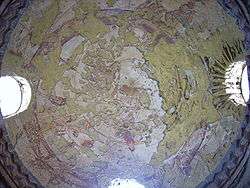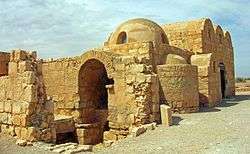Qasr Amra
| Qasr Amra, Qusayr 'Amra | |
|---|---|
|
Native name Arabic: قصر عمرة | |
|
East (front) elevation and portion of south profile, 2009 | |
| Location | Zarqa Governorate, Jordan |
| Coordinates | 31°48′07″N 36°34′36″E / 31.801935°N 36.57663°ECoordinates: 31°48′07″N 36°34′36″E / 31.801935°N 36.57663°E |
| Elevation | 520m |
| Built | 743 A.D. |
| Official name: Quseir Amra | |
| Type | Cultural |
| Criteria | i, iii, iv |
| Designated | 1985 (9th session) |
| Reference no. | 327 |
| State Party |
|
| Region | Arab States |
 Location of Qasr Amra, Qusayr 'Amra in Jordan | |
Qasr Amra (قصر عمرة / ALA-LC: Qaṣr ‘Amrah), also transcribed as Quseir Amra or Qusayr Amra, is the best-known of the desert castles located in present-day eastern Jordan. It was built early in the 8th century, some time between 723 and 743, by Walid Ibn Yazid, the future Umayyad caliph Walid II, whose dominance of the region was rising at the time. It is considered one of the most important examples of early Islamic art and architecture. The discovery of an inscription during work in 2012 has allowed for more accurate dating of the structure.
The building is actually the remnant of a larger complex that included an actual castle, of which only the foundation remains. What stands today is a small country cabin, meant as a royal retreat, without any military function. It is most notable for the frescoes that remain on the ceilings inside, which depict, among others, a group of rulers, hunting, naked women and, above one bath chamber, an accurate representation of the zodiac. These have led to its designation as a UNESCO World Heritage Site, one of four in the country.[1] That status, and its location along Jordan's major east–west highway, relatively close to Amman, have made it a frequent tourist destination.
Building
Qasr Amra is on the north side of Jordan's Highway 40, roughly 85 kilometres (53 mi) from Amman and 21 kilometres (13 mi) southwest of Al-Azraq.[2] It is currently within a large area fenced off in barbed wire. An unpaved parking lot is located at the southeast corner, just off the road. A small visitor's center collects admission fees. The castle is located in the west of the enclosed area, below a small rise.

It is a low building made from limestone and basalt. The northern block, two stories high, features a triple-vaulted ceiling over the main entrance on the east facade. The western wings feature smaller vaults or domes.
Traces of stone walls used to enclose the site suggest it was part of a 25-hectare (62-acre) complex; there are remains of a castle which could have temporarily housed a garrison of soldiers. Just to the southeast of the building is a well 40 metres (130 ft) deep, and traces of the animal-driven lifting mechanism and a dam have been found as well.[2]
Today, Qasr Amra is in a poorer condition than the other desert castles such as Qasr Kharana, with graffiti damaging some frescoes. However, conservation work is underway supported by World Monuments Fund, the Istituto Superiore per la Conservazione ed il Restauro, and Jordan's Department of Antiquities.[3]
History
One of the six kings depicted is King Roderick of Spain, whose short reign dates the image, and possibly the building, to around 710. For a long time archaeologists believed that sitting caliph Walid I was the builder and primary user of Qasr Amra, but recently doubts have been cast. Now it is believed more likely that one of two princes who later became caliph themselves, Walid II or Yazid III, are more likely candidates for that role.[4]
Both spent long periods of time away from Damascus, the Umayyad seat, before assuming the throne. Walid was known to indulge in the sort of sybaritic activities depicted on the frescoes, particularly sitting on the edge of pools listening to music or poetry. One time he was entertained by performers dressed as stars and constellations, suggesting a connection to the sky painting in the caldarium. Yazid's mother was a Persian princess, suggesting a familiarity with that culture, and he too was known for similar pleasure-seeking.[4]
The abandoned structure was re-discovered by Alois Musil in 1898, with the frescoes made famous in drawings by an Austrian artist Alphons Leopold Mielich for Musil's book. In the late 1970s a Spanish team restored the frescoes. The castle was made a UNESCO World Heritage Site in 1985 under criteria i), iii), and iv) ("masterpiece of human creative genius", "unique or at least exceptional testimony to a cultural tradition" and "an outstanding example of a type of building, architectural or technological ensemble or landscape which illustrates a significant stage in human history").
Frescoes



Qasr Amra is most notable for the frescoes on the inside walls. The main entry vault has scenes of hunting, fruit and wine consumption, and naked women. Some of the animals shown are not abundant in the region but were more commonly found in Persia, suggesting some influence from that area. One surface depicts the construction of the building. Near the base of one wall a haloed king is shown on a throne. An adjoining section, now in Berlin's Pergamon Museum, shows attendants as well as a boat in waters abundant with fish and fowl.
An image known as the "six kings" depicts the rulers of neighbouring powers. Based on details and inscriptions in the image, four of the depicted kings are identified as the Byzantine Emperor, the Visigothic king Roderic, the Sassanid Persian Shah, and the Negus of Ethiopia.[5] The two others are unidentified, speculated to include Turkish, Chinese, or Indian rulers.[4][5] Its intent was unclear. The Greek word "NHKH", or nike, meaning victory, were discovered nearby, suggesting that the "six kings" image was meant to suggest the caliph's supremacy over his enemies.[4] Another possible interpretation is that the six figures are depicted in supplication, presumably towards the Caliph who would be seated in the hall.[5]
The apodyterium, or changing room, is decorated with scenes of animals engaging in human activities, particularly performing music. One ambiguous image has an angel gazing down on a shrouded human form. It has often been thought to be a death scene, but some other interpretations have suggested the shroud covers a pair of lovers.[4] Three blackened faces on the ceiling have been thought to represent the stages of life. Christians in the area believe the middle figure is Jesus Christ.
On the walls and ceiling of the tepidarium, or warm bath, are scenes of plants and trees similar to those in the mosaic at the Umayyad Mosque in Damascus. They are interspersed with naked females in various poses, some bathing a child. The caldarium or hot bath's hemispheric dome has a representation of the heavens in which the zodiac is depicted, among 35 separate identifiable constellations.
It is believed to be the earliest image of the night sky painted on anything other than a flat surface. The radii emerge not from the dome's center but, accurately, from the north celestial pole. The angle of the zodiac is depicted accurately as well. The only error discernible in the surviving artwork is the counterclockwise order of the stars, which suggests the image was copied from one on a flat surface.[4]
The frescoes in all rooms but the caldarium reflect the advice of contemporary Arab physicians. They believed that baths drained the spirits of the bathers, and that to revive "the three vital principles in the body, the animal, the spiritual and the natural," the bath's walls should be covered with pictures of activities like hunting, of lovers, and of gardens and palm trees.[4]
See also
- Desert castles
- Qasr al-Azraq, about 100 km (62 mi) east of Amman, Jordan
- Qasr al-Hallabat, about 60 km (37 mi) northeast of Amman, Jordan
- Qasr al-Hayr al-Gharbi, Syrian Desert
- Qasr al-Hayr al-Sharqi, Syrian Desert
- Hisham's Palace, in Arabic Qasr Hisham or Khirbet el-Mafjar on the West Bank near Jericho, Palestine
- Qasr Kharana, about 65 km (40 mi) east of Amman, Jordan
- Qasr al-Minya, on the Sea of Galilee, Israel
- Qasr Mshatta, about 35 km (22 mi) southeast of Amman, Jordan, with a large part of the Mshatta Facade now in the Pergamon Museum in Berlin
- Qasr Mushash or Qasr al-Muwaqqar, about 30 km (19 mi) south of Amman, Jordan
- Qasr al-Qastal, about 25 km (16 mi) south of Amman, Jordan
- Hammam as-Sarkh, about 55 km (34 mi) northeast of Amman, Jordan
- Al-Sinnabra, on the Sea of Galilee, Israel
- Qasr at-Tuba, about 95 km (59 mi) southeast of Amman, Jordan
- History of Medieval Arabic and Western European domes
- List of World Heritage Sites in Jordan
References
- ↑ "21 World Heritage Sites you have probably never heard of". Daily Telegraph.
- 1 2 Khouri, Rami (September–October 1990). "Qasr'Amra". Saudi Aramco World. 41 (5). Retrieved 2009-05-18.
- ↑ "World Monuments Fund, Qusayr ‘Amra"
- 1 2 3 4 5 6 7 Baker, Patricia (July–August 1980). "The Frescoes of Amra". Saudi Aramco World. 31 (4): 22–25. Retrieved 2009-05-28.
- 1 2 3 Williams, Betsy. "Qusayr 'Amra". The Metropolitan Museum of Art.
Bibliography
- Martin Almagro, Luis Caballero, Juan Zozaya y Antonio Almagro, Qusayr Amra : residencia y baños omeyas en el desierto de Jordania, Ed. Instituto Hispano-Arabe de Cultura, 1975
- Martín Almagro, Luis Caballero, Juan Zozaya y Antonio Almagro, Qusayr Amra : Residencia y Baños Omeyas en el desierto de Jordania, Ed. Fundación El Legado Andalusí, 2002
- Garth Fowden, Qusayr 'Amra : Art and the Umayyad Elite In Late Antique Syria, Ed. University of California Press, 2004
- Claude Vibert-Guigue et Ghazi Bisheh, Les peintures De Qusayr 'Amra, Ed. Institut français du Proche-Orient, 200
- Hana Taragan, "Constructing a Visual Rhetoric: Images of Craftsmen and Builders in the Umayyad Palace at Qusayr ‘Amra," Al-Masaq: Islam and the Medieval Mediterranean, 20,2 (2008), 141-160.
External links
| Wikimedia Commons has media related to Quseir Amra. |
- Christian Sahner, "Snapshot of a Civilization in the Making," The Wall Street Journal, 27 November 2010
- UNESCO World Heritage Site listing
- Qusayr 'Amra, Archnet Digital Library
- Pictures of the sight, many fresco's
